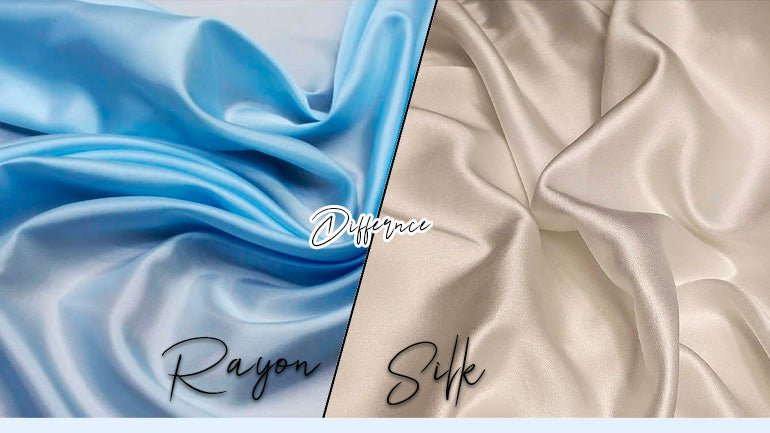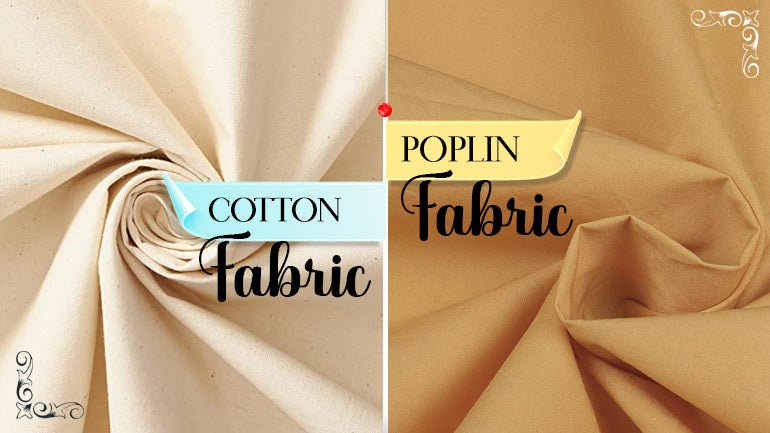Silk and rayon are two widely used fabrics in the world of fashion and textiles, each with its own set of characteristics and qualities that share certain similarities that often lead to questions like, "Is rayon better than silk?" or "Does rayon feel like silk?"
Have you ever questioned the distinction between silk fabric and rayon fabric while shopping? Both have a beautiful shine and feel very soft to the touch. What is the difference between them? It's easy to see that from the beginning, rayon has the same appearance as silk but at a fraction of the cost. However, silk is a different fabric that has gained popularity over the decades.
There are recognizable similarities when handling silk and rayon textiles, characterized by their lush fabric, soft texture, and lustrous sheen. Distinguishing between these delicate fabrics can be challenging, but comparing them and discussing rayon vs. silk will be fascinating. When you're done, I'm sure you'll know what makes these unique materials so popular.
Key Difference Between Rayon and Silk
We will discuss the key differences between silk and rayon. Why is rayon preferred over silk? And many more.
Origin
Silk: Silk is a natural fiber that has been produced for centuries. It originates from the silkworm, which spins a cocoon made of a protein called fibroin. The silk threads are carefully harvested from these cocoons, making it a luxurious and sought-after natural fabric.
Rayon: Rayon, on the other hand, is a synthetic or semi-synthetic fiber made from cellulose, often derived from wood pulp or bamboo. Despite its semi-synthetic nature, rayon is considered a regenerated cellulose fiber due to the use of natural materials in its production. It was developed as an alternative to silk, offering similar qualities at a more affordable price point.
Manufacturing Process
Silk: The manufacturing process of silk involves a natural and intricate procedure. Silkworms are raised in controlled environments, and their cocoons are carefully collected. These cocoons are then boiled in hot water to soften the sericin, a natural gum that holds the silk fibers together. Once softened, the fibers are unraveled, spun into threads, and woven into fabric.
Rayon: Rayon is manufactured through a chemical process that begins with the extraction of cellulose from wood pulp or bamboo. The cellulose is then dissolved in a chemical solution to create a viscous liquid. This liquid is forced through small openings, producing filaments that are solidified into fibers. This process is known as "regeneration" and is what classifies rayon as a regenerated cellulose fiber.
Appearance
Silk: Silk is renowned for its natural sheen and lustrous appearance. It has a smooth and glossy surface that reflects light beautifully. This characteristic makes silk a favored choice for elegant and formal attire.
Rayon: Rayon also possesses a certain level of sheen, but it is typically less lustrous than silk. Its appearance can vary depending on the manufacturing process and finishing treatments applied. Rayon fabrics can mimic the look of silk, but they may not achieve the same level of natural radiance.
Texture
Silk: Silk is celebrated for its luxurious texture. It is incredibly smooth and has a soft, silky feel against the skin. The fine fibers of silk contribute to its exceptional comfort and sensuousness.
Rayon: Rayon is known for its softness as well, but it may not reach the same level of luxuriousness as silk. It has a comfortable and pleasant texture, making it suitable for various types of clothing, including casual wear.
Draping
Silk: One of silk's outstanding characteristics is its graceful draping ability. It flows elegantly and follows the body's contours, creating a flattering and glamorous appearance. This quality makes silk a preferred choice for evening gowns and formal dresses.
Rayon: Rayon also drapes well but may not possess the same degree of natural grace as silk. It has a versatile drape that can adapt to various garment styles, making it suitable for both casual and semi-formal attire.
Breathability
Silk: Silk is known for its exceptional breathability. It has natural temperature-regulating properties that help keep the body cool in hot weather and warm in colder climates. This makes silk an excellent choice for all-season comfort.
Rayon: Rayon's breathability can vary depending on the specific weave and finishing processes. While it generally offers good breathability, it may not provide the same level of natural temperature control as silk. It is still a comfortable choice for a wide range of weather conditions.
Affordability
Silk: Silk is considered a luxury fabric, and its price reflects this status. The labor-intensive process of harvesting silkworms and the limited supply of natural silk fibers contribute to its higher cost. Silk is often reserved for special occasions and premium fashion.
Rayon: Rayon is known for its affordability compared to silk. Its manufacturing process is more cost-effective, making it accessible to a broader range of consumers. Rayon provides an excellent alternative for those seeking silk-like qualities without the premium price tag.
Care
Silk: Silk is a luxurious natural fiber obtained from the cocoons of silkworms. It is known for its delicate and smooth texture. Caring for silk requires special attention. It is advisable to hand wash silk garments in cold water with a mild detergent. Avoid twisting or wringing the fabric, and never bleach silk, as it can damage the fibers. Additionally, silk should be kept away from direct sunlight to prevent color fading.
Get complete story on How to Wash and Care Silk Fabric?
Rayon: Rayon, on the other hand, is a synthetic fiber made from cellulose extracted from wood pulp or bamboo. It is often considered more forgiving when it comes to care. Rayon garments can usually be machine-washed on a gentle cycle with a mild detergent. However, it's essential to check the care label, as some rayon fabrics may require delicate handling. They should be hung or laid flat to dry to avoid stretching.
Learn our guide on Does Rayon Shrink When Washed to protect your elegant rayon clothes from losing their shape.
Moisture-Wicking Properties
Silk: Silk has natural moisture-wicking properties, which means it can absorb moisture and keep you comfortable in hot and humid conditions. It helps wick away sweat from your body, leaving you feeling cool and dry.
Rayon: Rayon also possesses moisture-wicking qualities, although it may not be as effective as silk. It can still absorb moisture, making it a good choice for clothing items that need to keep you comfortable in warm weather.
Temperature Regulation
Silk: Silk is renowned for its temperature-regulating abilities. It can keep you warm in cold weather by trapping heat close to your body, and it also provides a cooling effect in hot weather due to its breathability. This makes silk a versatile fabric suitable for various climates.
Rayon: Rayon, while breathable, may not offer the same level of temperature regulation as silk. It can be comfortable in warm weather but may not provide the same insulating warmth in colder conditions.
Comfort
Silk: Silk is often associated with unparalleled comfort. Its soft, smooth texture feels gentle against the skin, making it a favorite choice for lingerie, sleepwear, and luxurious clothing items. It drapes beautifully and is known for its hypoallergenic properties.
Rayon: Rayon is comfortable to wear, but its comfort level may vary depending on the specific type of rayon fabric. It can be soft and breathable, providing comfort in various settings. However, it may not offer the same luxurious feel as silk.
Luxury
Silk: Silk has been synonymous with luxury for centuries. Its sheen, softness, and timeless appeal make it a preferred choice for high-end fashion, evening gowns, and accessories. Wearing silk often signifies elegance and sophistication.
Rayon: Rayon, while versatile and attractive, may not exude the same level of luxury as silk. It is more commonly used in casual or everyday clothing and is considered a more budget-friendly alternative to silk.
Durability
Silk: Silk is a delicate fabric that requires careful handling to maintain its integrity. While it is relatively strong, it can be prone to snagging and damage if not cared for properly. The longevity of silk garments depends on how well they are maintained.
Rayon: Rayon can vary in terms of durability depending on its quality and construction. Some types of rayon may be more prone to wrinkling or pilling than others. However, in general, rayon is considered less durable than silk and may not withstand heavy wear and tear as effectively.
Also read for Rayon vs Spandex Fabric.
Environmental Considerations
Silk: Silk is a natural fiber, but its production involves sericulture, the process of raising silkworms and harvesting their cocoons. This process can have environmental impacts, including the use of resources and energy. However, there are sustainable and eco-friendly practices emerging in the silk industry.
Rayon: Rayon is a synthetic fiber, but it is derived from renewable sources such as wood pulp and bamboo. While the manufacturing process of rayon involves chemicals, advancements have been made to minimize environmental harm. Some types of rayon, like lyocell (Tencel), are considered more eco-friendly due to their closed-loop production processes.
Cost
Silk: Silk is renowned for its luxurious and opulent feel, often associated with high-end fashion and exquisite craftsmanship. This premium quality comes at a price, as silk is one of the most expensive natural fibers available. The production of silk involves a labor-intensive process of harvesting silk threads from silkworm cocoons, which significantly contributes to its elevated cost.
Rayon: Rayon, on the other hand, is considerably more affordable compared to silk. It is a man-made fiber, also known as "artificial silk" or "viscose," and is created through a chemical process involving wood pulp or cellulose fibers. The cost-effectiveness of rayon makes it a popular choice for various applications, allowing consumers to enjoy the look and feel of silk without the hefty price tag.
Versatility
Silk: Silk is celebrated for its versatility in fashion and textile applications. It possesses a natural ability to regulate temperature, making it comfortable to wear in both warm and cold weather. Silk's moisture-wicking properties keep the skin dry, making it an excellent choice for undergarments, sleepwear, and activewear. It's shimmering appearance and soft drape also make it a preferred fabric for evening gowns, lingerie, and high-end accessories.
Rayon: Rayon, while not as temperature-regulating as silk, is highly versatile in its own right. It can imitate the look and feel of silk, cotton, or linen, depending on the manufacturing process. Rayon fabrics are breathable and moisture-absorbent, making them suitable for a wide range of clothing, including casual wear, dresses, blouses, and sportswear. Rayon's adaptability extends to home textiles like curtains, upholstery, and bed linens.
Hypoallergenic Properties
Silk: Silk is a natural fiber, and it is known for its hypoallergenic properties. Its smooth and tightly woven surface reduces the likelihood of trapping allergens such as dust mites and pollen, making it an excellent choice for individuals with allergies or sensitive skin. Silk's natural proteins also help maintain the skin's moisture balance and reduce the risk of irritation.
Rayon: Rayon's hypoallergenic properties are more variable compared to silk. While it is less likely to trigger allergies compared to some synthetic fabrics, it may not provide the same level of allergen resistance as silk. The specific characteristics of rayon can vary depending on its production process, so individuals with sensitivities should choose rayon blends carefully.
Versatility
Silk: Silk is synonymous with luxury and extravagance. Its rich history and association with royalty and high society have cemented its status as a symbol of opulence. Silk garments and accessories are often considered investments due to their durability and timeless appeal. However, the luxurious nature of silk may limit its everyday practicality for some individuals.
Rayon: Rayon offers a more practical and accessible alternative to silk. Its affordability and versatility make it suitable for everyday wear and a variety of budget-conscious applications. Rayon's adaptability allows it to cater to a wide range of consumer needs without compromising on quality or comfort.
Common Uses
Silk:
- Evening gowns and formalwear
- Lingerie and intimate apparel
- Silk scarves and ties
- Bedding and pillowcases
- High-end upholstery and drapery
Rayon:
- Casual clothing and sportswear
- Blouses and dresses
- T-shirts and activewear
- Curtains and drapes
- Bed linens and towels
Availability
Silk: Silk is produced mainly in countries like China, India, and Brazil, which are known for their sericulture traditions. The limited geographic distribution of silkworms restricts the global availability of silk, contributing to its exclusivity and higher cost.
Rayon: Rayon is more widely available across the globe. Its production is not limited by geographic factors, as it is created from wood pulp or cellulose fibers that can be sourced from various regions. This widespread availability contributes to its affordability and accessibility.
Imitation Potential
Silk: Silk is challenging to imitate convincingly due to its unique properties and shimmering appearance. While there are silk blends and synthetic alternatives, genuine silk remains distinguishable to those familiar with its texture and sheen.
You may also want to find Satin vs Silk.
Rayon: Rayon, often referred to as "artificial silk," is intentionally designed to imitate the look and feel of silk. Depending on the manufacturing process and treatment, rayon can closely resemble silk, making it a cost-effective alternative for those seeking the luxurious aesthetic of silk without the associated price.
Comparison table: Silk vs Rayon
|
Features |
Silk |
Rayon |
|
Origin |
Natural fiber from silkworms |
Semi-synthetic from wood pulp or bamboo |
|
Manufacturing Process |
Intricate, involving silkworms and cocoon |
Chemical process involving cellulose extraction |
|
Appearance |
Natural sheen and lustrous |
Varies, can mimic silk but less lustrous |
|
Texture |
Luxurious and smooth |
Soft, but may not be as luxurious |
|
Draping |
Graceful and follows body contours |
Drapes well but may not have the same grace |
|
Breathability |
Exceptional |
Good, but not as effective as silk |
|
Affordability |
Expensive |
Affordable, accessible to a wider range |
|
Care |
Delicate, requires special attention |
Generally more forgiving in care |
|
Moisture-Wicking Properties |
Absorbs moisture effectively |
Absorbs moisture but may not be as effective |
|
Temperature Regulation |
Excellent for all seasons |
Comfortable in warm weather, less insulating |
|
Comfort |
Known for unparalleled comfort |
Comfortable but may not feel as luxurious |
|
Luxury |
Symbolizes luxury and sophistication |
More budget-friendly and less luxurious |
|
Durability |
Delicate, requires careful handling |
Varies, may be less durable than silk |
|
Environmental Considerations |
Involves resource use and energy |
Derived from renewable sources, eco-friendly types |
|
Cost |
Expensive due to labor-intensive process |
More affordable, accessible to many consumers |
|
Versatility |
Suitable for various applications |
Versatile, imitates different fabrics |
|
Hypoallergenic Properties |
Hypoallergenic due to tightly woven surface |
Variable, depends on production process |
|
Common Uses |
Eveningwear, lingerie, scarves, bedding |
Casualwear, blouses, T-shirts, curtains, linens |
|
Availability |
Limited geographic distribution |
Widespread availability across regions |
|
Imitation Potential |
Difficult to convincingly imitate |
Designed to closely resemble silk |
Expand your knowledge on Velvet vs Silk.
Faqs
Is Rayon More Durable Than Silk?
In terms of durability, rayon generally outperforms silk. Silk is a delicate fabric that can be easily damaged by abrasion, exposure to sunlight, and perspiration. It is more susceptible to tearing and stretching than rayon. While silk should be handled with care and may not be as long-lasting as rayon, its exceptional softness and sheen compensate for its lower durability.
Is Rayon More Expensive Than Silk?
No, rayon is generally less expensive than silk. The production process of silk is labor-intensive and relies on the cultivation of silkworms, making it a costly material. In contrast, rayon is manufactured from readily available natural sources like wood pulp, making it a more budget-friendly option for those seeking a similar look and feel to silk without the high price tag.
Can Silk and Rayon Fabrics Be Blended Together?
Yes, silk and rayon fabrics can be blended together to create a hybrid textile that combines the benefits of both fibers. This blend offers the softness and sheen of silk with the added durability and affordability of rayon. The resulting fabric is often used in a variety of applications, including evening wear, formal suits, and high-end drapery.
Do Silk and Rayon Fabrics Shrink?
Both silk and rayon fabrics can shrink when exposed to moisture and heat. To prevent shrinkage, it's essential to follow proper care instructions for each fabric. Dry cleaning is a safe option for maintaining the size and shape of silk garments, while rayon should be washed gently in cold water and air-dried to minimize shrinkage.



